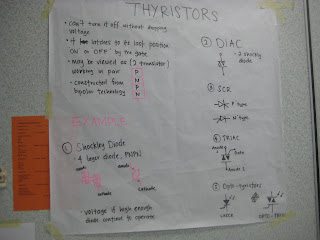The module 4 is for Fundamental Electronics. It has 2 distinct group of knowledge. The syllabus includes:
- subject of electronics and the second part
- includes the non electronic subject of syncro.
I presume that EASA realise the importance of subjects of data transmission like syncro and they cannot find a suitable module.As such it is parked in module 5.
In the learning theory, the researches had identified the effectiveness of the teaching medium.
- virtual
- audio
- experiential
It had been found that experiential learning is more effective. That mean, learning by doing will improve the learning and the students memory. We were using this method in the delivery.
We include some of the students activities..
Thrystors are generic term used to describe the semiconductors that have the latching effect. The most commonly used is the SCR, the silicon controlled rectifier. A SCR has 3 connecting wires, the anode, the cathode and the gate.
The + is connected to the anode and (-) connected to the cathode. The gate is the controlling input. With a positive pulse, the current will flow from anode to cathode and it continue to flow until the voltage falls below a certain level.
We covers the half wave and full wave rectifiers. For the full wave rectifier, we study the two types, the center tapped full wave rectifier that uses only two diodes. We also study the bridge type of rectifier which uses 4 diodes.
We did not cover the 3 phase rectifier. That remind me, to include the 3 phase rectifier, as it is the most common type used in the modern aircraft, noticeably for TRUs and the voltage regulators.
We covered rather in detail about the operation amplifiers. Covering the above topics, we cover the operation of 3 types of Op amplifiers, the inverting, the summing and comparator.





No comments:
Post a Comment